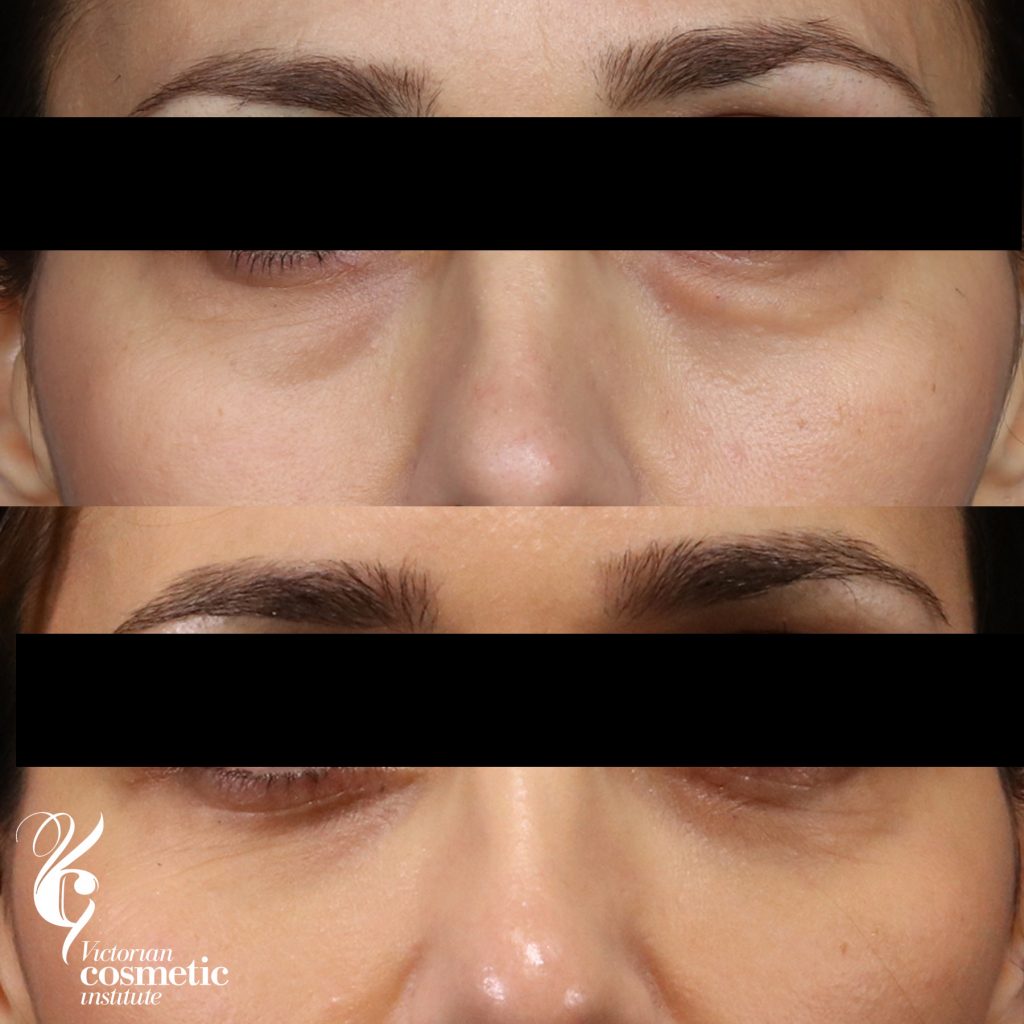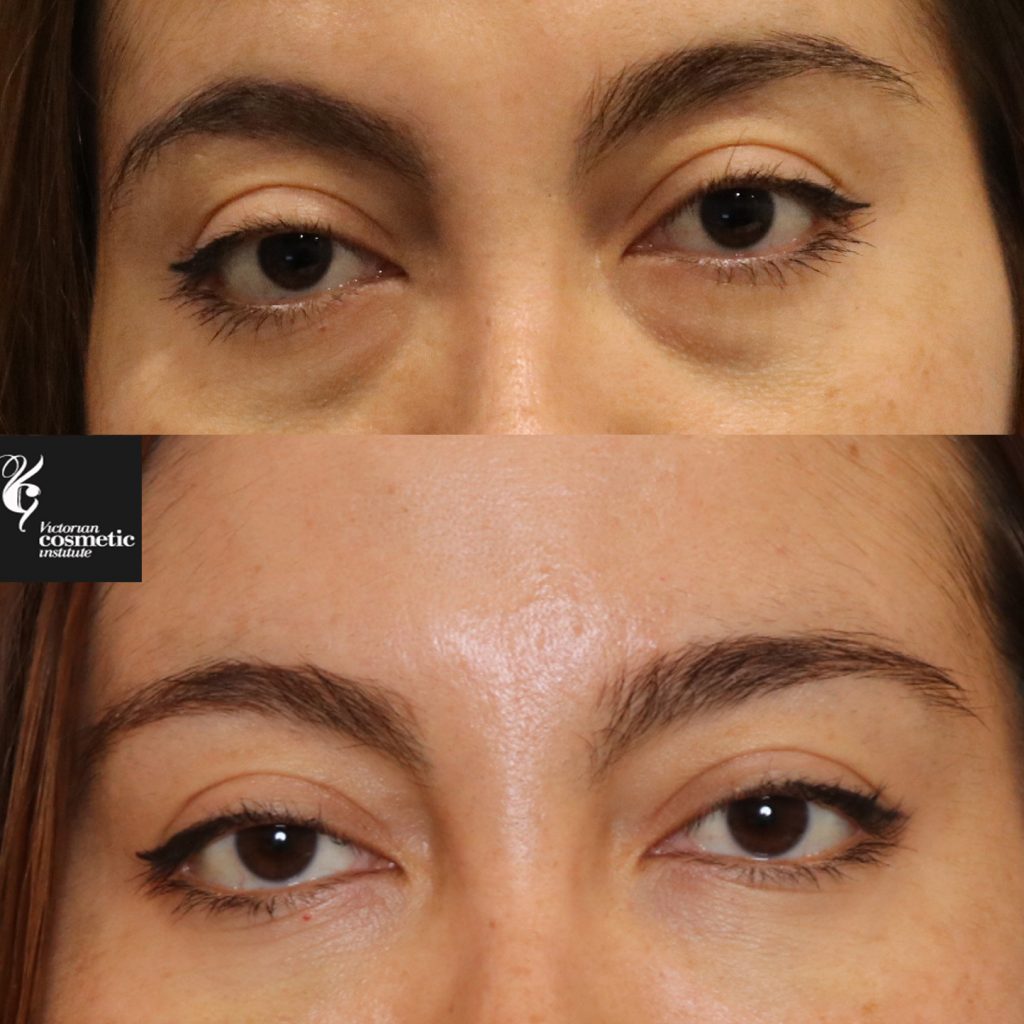Last updated November 2021
Consultations for tear trough fillers are no longer provided at VCI. The below is for information purposes only.
What are tear troughs?
Tear troughs are the hollows between the lower eyelid and the cheeks. This groove is often an aesthetic concern as it may cause the appearance of tiredness. A deep under eye crease can be caused by genetics, or it can be the result of ageing – facial tissue often loses volume with age.
What causes deep tear troughs?
In many cases, tear troughs are genetic and often begin to appear in childhood. Often, the cause is tethering of the tear trough skin to the orbital bone below. The anatomical basis for the tear trough was first found by Melbourne plastic surgeon, Mr. Bryan Mendelson in 2012. He discovered a true osteocutaneous (bone to skin) ligament, the tear trough ligament, that had not previously been discovered through normal dissection techniques.
Ageing can also exacerbate the tear trough deformity as;
- the lower eyelid fat prolapses further forward and starts to protrude outwards
- the quality of the lower eyelid skin worsens, resulting in loss of skin elasticity
- the mid-cheek loses bone and fat volume, causing loss of support for the lower eyelid
In some cases, very dark shadows or under eye circles can be a result of pigmentation, rather than a deep crease. If this is the case, tear trough fillers will not solve the problem.
How can I treat my tear troughs with dermal filler?
The appearance of tear troughs can be reduced with the injection of dermal fillers. The type of filler that is used is usually made of hyaluronic acid, which is a substance that naturally exists in your body. When injected into the space under the tear troughs, hyaluronic acid reduces depth and improves the appearance of dark circles.
Injecting around the eye area is more difficult and requires more precision than other procedures. Tear trough fillers often last longer than cheek, lip or forehead fillers, because this area of your face doesn’t move very much; which means that there are more risks associated with it.
A common technique for correcting tear troughs is to inject dermal filler directly into the groove between the lower eyelid and cheek. We no longer recommend under eye filler injections using this method for the following reasons;
- Fillers placed in this area often last for many years.
- During this time, the filler may migrate to other areas in the lower eyelid or orbit and cause lower eyelid puffiness.
- The tear trough ligament in many cases strongly tethers the skin to the orbital bone, and this makes it difficult if not impossible to lift with fillers.
- Filler injection directly into the tear trough can lead to inadvertent injection of filler beyond the orbital septum. The orbital septum is the septum that divides the front and back of the orbit. If filler is injected behind the septum, then essentially the filler is placed under the globe (the ‘eyeball’). This may cause puffiness and a significant amount of difficulty in dissolving the filler with hyaluronidase (an enzyme that breaks down the injectables) should this occur. The hyaluronidase would need to be injected beneath the globe as well, which could be difficult and dangerous without the assistance of ultrasound guidance.
Loss of volume in the mid-cheek can also cause hollowing between the lower eyelid and cheek and exacerbate the appearance of tear troughs. It is possible to replace volume in the mid-cheek using dermal fillers to correct this problem. This method was advocated in Mendelson’s 2012 study – instead of filling the tear trough directly, filler could be used in the mid-cheek to help lift and support the tear trough ligament from beneath, reducing the appearance of prominent tear troughs. In most cases, only 1ml will be required to treat both sides of the face.
Assessment of the under eye region
Many people consider getting tear trough fillers after using eye cream and not getting the results that they wanted. If the cause of your dark circles and tired looking eyes is because of a prominent tear trough, fillers will make a noticeable difference. However, if it is due to pigmentation or a noticeable colour difference, fillers will not be suitable. Tear trough fillers can also be used to treat noticeable puffy eye bags or volume loss in the tear trough area. Patients with thick, healthy skin and realistic expectations about the procedure are the best candidates.
If the skin around your eye area is very thin or loose you may not be a good candidate for tear trough filler. If you have an active skin infection or condition in the eye area, or if you have an underlying medical condition, you also may not be a good candidate.
How can I treat my tear troughs surgically?
As an alternative to dermal fillers, fat transfer from another part of the body can be used to fill in any hollows. This involves a minor liposuction to harvest fat from an area such as the abdomen, and then injecting this fat into the mid-cheek or areas of the face that have suffered from volume loss. Note that we do not inject fat directly into the tear trough for the same reasons we do not inject filler there.
The fat that is transferred then regenerates in its new position, and acts in a similar way to a dermal filler to increase volume and smooth the skin in the tear trough region. Fat transfer is considered a permanent procedure, and is more invasive than getting dermal fillers. Therefore, it is necessary to slightly under-fill the area, as any lumps or excess fat may require further surgery to remove. Fat does have the advantage of not being hydrophilic (attracted to water), and once settled in, seems to have less fluctuations in volume in comparison to dermal fillers.
Surgically, a lower eyelid blepharoplasty can be performed to remove the excess skin and fat from under the eyes. The tear trough ligament that attaches the skin to the orbital bone can be released surgically. The fat from the lower eyelid can also be transposed to the tear trough groove to smooth and even the contour of the area. A small amount of skin can be ‘pinched’ and removed to tighten the skin of the lower eyelid.
What to expect during the treatment
Before you have the procedure, you’ll have a consultation with a medical professional to check the thickness of your skin in the eye area and determine what type and how much dermal filler you will need.
The actual treatment will take place in a medical office or clinic. First, the surgeon will disinfect your skin and then either apply a topical anaesthetic (numbing cream) or an ice pack to the injection site. This is done to reduce bruising.
The doctor may talk to you about the procedure while they mark your face.
Next, the doctor will prepare a syringe containing the dermal filler. They will inject the filler into the mid-cheek area on both sides, to support and lift the tear trough.
The surgeon may massage the area lightly in order to spread the filler.
Risks/side effects
The area around the eyes and tear troughs is a space with very delicate anatomy, so it may have more risks associated with it than other cosmetic procedures. One of the most common side effects of tear trough fillers is prolonged swelling that creates an unnatural or puffy appearance. It is also possible for the dermal fillers to migrate to another area of the face and form lumps or trigger an infection. You should see your doctor immediately if you have any of the following symptoms more than a few days after the surgery:
- Bruising or swelling that is getting worse
- Numbness of the face
- Vision changes
- Lumps or signs of infection
Post procedure recovery and aftercare
You will most likely have some swelling and bruising for 48-72 hours after the treatment. You can treat this by applying ice to the area. You should avoid any rigorous activity for a few days after the treatment and you should avoid sleeping face down.
For most patients, it will take 1-2 weeks to see the full results of the procedure. You will also have a review appointment a couple of weeks after the treatment to make sure there are no problems.
FAQ’s
Is tear trough filler painful?
It will depend on your individual pain threshold and the level of sensitivity in your face, but most people will only experience mild discomfort during the treatment. Numbing cream is used to reduce the feeling of the needle.
You may have some pain and bruising for a few days afterwards, but this should clear up quickly.
How much does eye trough filler (under eye fillers) cost?
Tear trough filler cost depends on the thickness of your skin and the amount of dermal filler required.
Prices start from $875 for a 1ml syringe for 1 session.
For the full price list click here.
Under eye filler is not covered by insurance because it is considered cosmetic and non essential.
How effective is tear trough filler?
Tear trough filler is very effective at creating a refreshed, rejuvenated appearance that reduces dark circles and under eye puffiness. If you have deep tear troughs that cause you concern, this treatment will provide effective results.
You will need to repeat the treatment every 1-2 years in order to maintain the effects of the dermal filler.
Is filler under the eye dangerous?
As with many procedures, there are risks associated with getting cosmetic injections. However, the experienced professionals at VCI are trained to perform this procedure safely.
Which filler is best for under eyes?
The type of filler that you will need will be discussed in your initial consultation with your provider.

